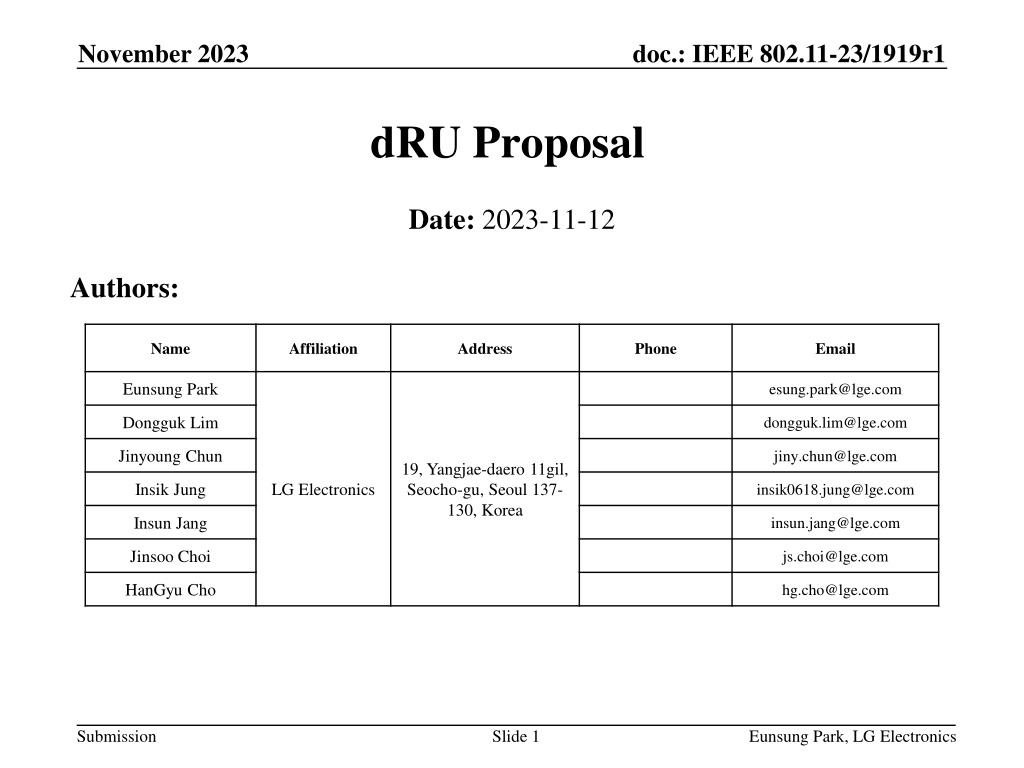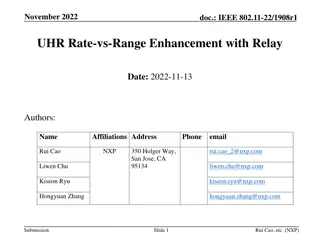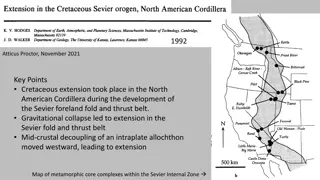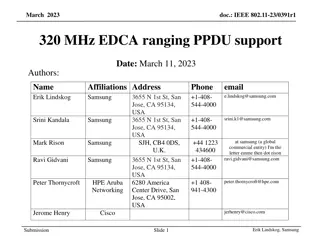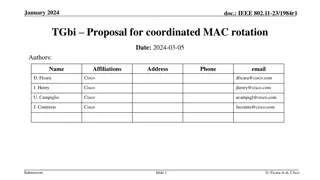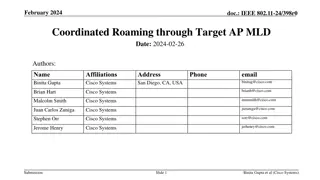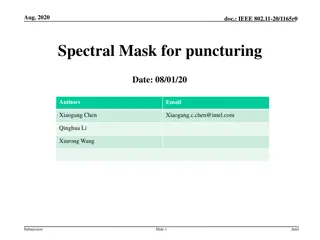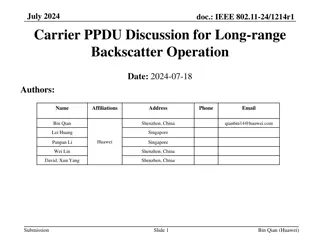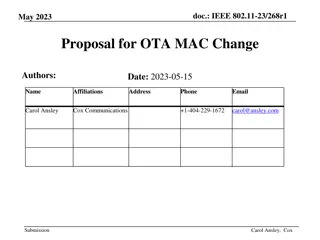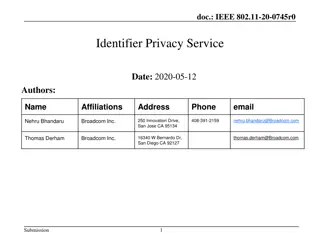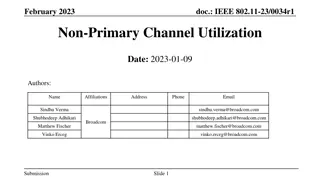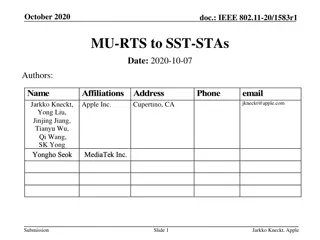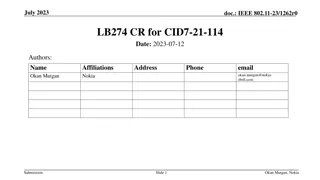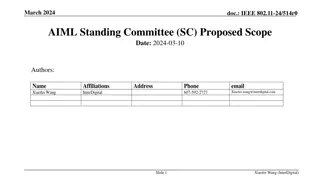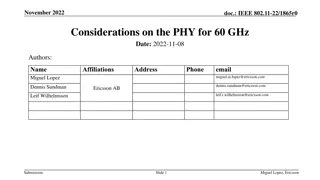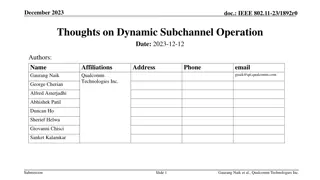IEEE 802.11-23/1919r1dRU Proposal for Range Extension and RvR Enhancement
This proposal introduces dRU support for 11bn to overcome PSD limitations, enabling range extension and RvR enhancement. It reviews previous dRU contributions in UHR SG and details new proposals including distributed tones across channels, dRU tone plans in different MHz channels, and pilot designs for improved performance under residual CFO values. The proposal aims to optimize dRU allocation and enhance transmission power efficiency for UL OFDMA in 6 GHz scenarios.
Download Presentation

Please find below an Image/Link to download the presentation.
The content on the website is provided AS IS for your information and personal use only. It may not be sold, licensed, or shared on other websites without obtaining consent from the author. Download presentation by click this link. If you encounter any issues during the download, it is possible that the publisher has removed the file from their server.
E N D
Presentation Transcript
November 2023 doc.: IEEE 802.11-23/1919r1 dRU Proposal Date: 2023-11-12 Authors: Name Affiliation Address Phone Email Eunsung Park esung.park@lge.com Dongguk Lim dongguk.lim@lge.com Jinyoung Chun jiny.chun@lge.com 19, Yangjae-daero 11gil, Seocho-gu, Seoul 137- 130, Korea Insik Jung LG Electronics insik0618.jung@lge.com Insun Jang insun.jang@lge.com Jinsoo Choi js.choi@lge.com HanGyu Cho hg.cho@lge.com Submission Slide 1 Eunsung Park, LG Electronics
November 2023 doc.: IEEE 802.11-23/1919r1 Introduction In this contribution, we propose to support dRU for 11bn which can achieve range extension and RvR enhancement by overcoming PSD limitations We first review all the dRU contributions presented in UHR SG and then go over details on our proposals Submission Slide 2 Eunsung Park, LG Electronics
November 2023 doc.: IEEE 802.11-23/1919r1 Recap on dRU Contributions (1/5) In [1], dRUs where their tones are distributed across a channel were introduced to overcome PSD limitations It was shown that dRU can significantly boost the transmit power for a UL OFDMA transmission especially in a 6 GHz LPI case In [2], dRU design ways were discussed as follows dRU tone plans are defined in 20 / 40 / 80 MHz channels The existing RU Allocation subfield is reused for dRU allocation dRUs and rRUs are not used at the same time within 20 MHz For a dRU tone plan, the basic tone size of dRUs and the configuration of dRUs in each channel (i.e., combination of different dRUs in each channel) are defined the same as the conventional rRU tone plan Large size dRUs are built by combining small size dRUs (and null tones depending on the dRU size) An additional subfield for dRU indication (e.g., whether it is dRU or rRU for each 20MHz channel) is defined Slide 3 Submission Eunsung Park, LG Electronics
November 2023 doc.: IEEE 802.11-23/1919r1 Recap on dRU Contributions (2/5) [3] and [4] introduced several pilot designs using new pilot tones or conventional pilot tones for dRU and investigated their performance under various residual CFO values For a 26 dRU, three pilot options were discussed Option 1: 7th and 20th tones among 26 distributed tones allocated to each 26 dRU are used as pilot tones Option 2: 24 distributed tones are allocated to each 26 dRU as data tones and then two conventional pilot tones of 26 rRU_x (i.e., x-th 26 rRU) are additionally allotted to 26 dRU_x (i.e., x-th 26 dRU) as pilot tones Option 3: 24 distributed tones are allocated to each 26 dRU as data tones and then two conventional pilot tones which are located far enough away are allotted to each 26 dRU as pilot tones It was shown that dRU performance varies according to the pilot design and pilot tones with a sufficient gap can improve the performance Option 1 and 3 have a similar performance which is better than that of option 2 Submission Slide 4 Eunsung Park, LG Electronics
November 2023 doc.: IEEE 802.11-23/1919r1 Recap on dRU Contributions (3/5) [5] discussed how to build dRU tone plans and how to allocate dRUs to STAs by reusing the rRU allocation method E.g., one possible procedure to build a 20 MHz dRU tone plan DC, guard and null tones defined in the 20 MHz rRU tone plan are maintained and nine 26 dRUs are defined by allocating available tones to each dRU in turn Each of four 52 dRUs is defined by combining different two 26 dRUs Each of two 106 dRU is defined by combining different two 52 dRUs and two tones which are null tones in 26 / 52 rRUs but not in 106 rRUs Two dRUs which guarantee an enough tone space can be combined Based on the combinations for dRUs and rRUs, each dRU can be mapped to a certain rRU and consequently the conventional rRU allocation can be reused for dRU allocation E.g., combinations for 106 rRU / dRU and the mapping rule for 52 dRUs In this case, it is assumed that 106 dRU_1 and 106 dRU_2 are mapped to 106 rRU_1and 106 rRU_2, respectively Submission Slide 5 Eunsung Park, LG Electronics
November 2023 doc.: IEEE 802.11-23/1919r1 Recap on dRU Contributions (4/5) In [6], further issues were dealt with in designing a dRU tone plan Issue 1: Channel widths in which dRU tone plans should be designed It was recommended to define dRU tone plans up to 160 MHz Issue 2: How to perform a dRU transmission when preamble puncturing is applied A simple approach was recommended which uses dRU tone plans for small bandwidths, e.g., 20 MHz and 40 MHz dRU tone plans are used for a 80 MHz channel where one 20 MHz channel is punctured Issue 3: Minimum and maximum dRU sizes depending on the channel width It was recommended to consider defining only some large dRUs in a 80 / 160 MHz dRU tone plan Submission Slide 6 Eunsung Park, LG Electronics
November 2023 doc.: IEEE 802.11-23/1919r1 Recap on dRU Contributions (5/5) [7] discussed pilot tone allocation for dRU by showing their impact on PER performance and introduced a tone group based dRU It was confirmed that allocating the conventional pilot tones spaced with a sufficient distance for dRUs improves the PER performance It was also stated that tone group based dRU may allow for early phase tracking by employing the LTFs and the residual CFO requirements for dRUs may need discussion [8] discussed a use case for dRU in downlink It was confirmed that rate adaptation could be performed independently of the location or size of the dRU by comparing the channel conditions between rRUs and dRUs A single set of pilot tones were also introduced which can be used/shared by all of the distributed RUs Submission Slide 7 Eunsung Park, LG Electronics
November 2023 doc.: IEEE 802.11-23/1919r1 Proposals (1/4) 11bn supports a dRU for a TB PPDU transmission in a 6 GHz band It is possible for non-AP STAs to overcome PSD limitation and to boost the transmit power in a TB PPDU where one dRU is assigned to each STA basically Whether it is mandatory or optional should be further discussed Support for a dRU in other PPDUs and different bands also needs more discussion When allocating RUs within a 20 MHz channel for a PPDU transmission, 11bn only allows to allocate either rRUs or dRUs If 11bn allows an AP to allocate both rRUs and dRUs at the same time, we may need to design dRU and rRU tone plans for less than 20 MHz which makes scheduling and signaling complicated Less than 20 MHz may not guarantee a sufficient boost of the transmit power for dRUs Submission Slide 8 Eunsung Park, LG Electronics
November 2023 doc.: IEEE 802.11-23/1919r1 Proposals (2/4) 11bn supports dRUs which consist of subcarriers spreading across up to 160 MHz channel Currently non-AP STAs support up to 80 MHz mandatorily Support for 160 MHz may become more common along with hardware improvement, and thus, it may be also possible that this support becomes mandatory for non-AP STAs in 11bn Also, in 160 MHz, various kinds of large dRUs are available with a better transmit power gain Whether it is mandatory or optional should be further discussed even in up to 80 MHz Details on how to define dRUs also need more discussion One possible approach is defining 20 MHz, 40 MHz, 80 MHz, 160 MHz dRU tone plans In addition, we also need to address preamble puncturing cases Submission Slide 9 Eunsung Park, LG Electronics
November 2023 doc.: IEEE 802.11-23/1919r1 Proposals (3/4) 11bn supports to allocate dRUs which spans a certain channel less than or equal to a bandwidth for a PPDU transmission as follows Allocate dRUs spanning a certain 20 MHz channel for a 20 MHz, 40 MHz, 80 MHz, 160 MHz or 320 MHz PPDU Allocate dRUs spanning a certain 40 MHz channel for a 40 MHz, 80 MHz, 160 MHz or 320 MHz PPDU Allocate dRUs spanning a certain 80 MHz channel for an 80 MHz, 160 MHz or 320 MHz PPDU Allocate dRUs spanning a certain 160 MHz channel for a 160 MHz or 320 MHz PPDU This approach enables to allocate dRUs to narrow operating bandwidth STAs in a wider bandwidth transmission similar to 11be resulting in better flexibility It also allows to support both dRU capable and non-capable STAs at the same time in one PPDU How to allocate and indicate dRUs should be further discussed Submission Slide 10 Eunsung Park, LG Electronics
November 2023 doc.: IEEE 802.11-23/1919r1 Proposals (4/4) 11bn supports dRUs which sizes are determined based on the conventional RU sizes as follows 26-, 52-, and 106-tone dRUs spanning a 20 MHz channel 26-, 52-, 106- and 242-tone dRUs spanning a 40 MHz channel 242- and 484-tone dRUs spanning a 80 MHz channel 242-, 484- and 996-tone dRUs spanning a 160 MHz channel We can reuse the existing implementation such as BCC interleaver, LDPC tone mapper, etc. Support for 26-, 52-, and 106-tone dRUs in 80 / 160 MHz is open for now There is a trade-off between flexibility and complexity Non-AP STAs cannot support dRUs spanning a channel wider than their operating bandwidths, and thus, in that case, even small dRUs cannot be used for STAs with a small operating bandwidth capability Details on the subcarrier indices and the number of dRUs need more discussion Submission Slide 11 Eunsung Park, LG Electronics
November 2023 doc.: IEEE 802.11-23/1919r1 Straw Poll #1 Do you agree to add the following text to the TGbn SFD? 11bn supports a distributed-tone RU (DRU) for a TB PPDU transmission The DRU means an RU which consists of subcarriers spreading across a certain bandwidth Y/N/A: // Submission Slide 12 Eunsung Park, LG Electronics
November 2023 doc.: IEEE 802.11-23/1919r1 Straw Poll #1-1 Do you agree to support dRUs for DL MU PPDU? This is for gathering information Y/N/A: // Submission Slide 13 Eunsung Park, LG Electronics
November 2023 doc.: IEEE 802.11-23/1919r1 Straw Poll #1-2 Do you agree to support dRUs for the bands other than the 6 GHz? This is for gathering information Y/N/A: // Submission Slide 14 Eunsung Park, LG Electronics
November 2023 doc.: IEEE 802.11-23/1919r1 Straw Poll #2 Do you agree to add the following text to the TGbn SFD? When allocating RUs within a 20 MHz channel for a PPDU transmission, 11bn only allows to allocate either rRUs or dRUs Note that the rRU indicates one of RUs or MRUs defined in 11be Y/N/A: // Submission Slide 15 Eunsung Park, LG Electronics
November 2023 doc.: IEEE 802.11-23/1919r1 Straw Poll #3 Do you agree to add the following text to the TGbn SFD? 11bn supports dRUs which consist of subcarriers spreading across 20 MHz, 40 MHz 80 MHz and 160 MHz channel Y/N/A: Submission Slide 16 Eunsung Park, LG Electronics
November 2023 doc.: IEEE 802.11-23/1919r1 Straw Poll #3-1 Do you agree to add the following text to the TGbn SFD? 11bn defines tone plans for 20 MHz, 40 MHz, 80 MHz and 160 MHz bandwidths, respectively Detailed tone plans are TBD Puncturing cases are TBD Y/N/A: Submission Slide 17 Eunsung Park, LG Electronics
November 2023 doc.: IEEE 802.11-23/1919r1 Straw Poll #4 Do you agree to add the following text to the TGbn SFD? 11bn supports to allocate dRUs which spans a certain channel less than or equal to a bandwidth for a PPDU transmission as follows Allocate dRUs spanning a certain 20 MHz channel for a 20 MHz, 40 MHz, 80 MHz, 160 MHz or 320 MHz PPDU Allocate dRUs spanning a certain 40 MHz channel for a 40 MHz, 80 MHz, 160 MHz or 320 MHz PPDU Allocate dRUs spanning a certain 80 MHz channel for an 80 MHz, 160 MHz or 320 MHz PPDU Allocate dRUs spanning a certain 160 MHz channel for a 160 MHz or 320 MHz PPDU Whether it is mandatory or optional is TBD Details on the size, subcarrier indices and the number of dRUs are TBD Detailed methods for dRU allocation and signaling are TBD Y/N/A: Submission Slide 18 Eunsung Park, LG Electronics
November 2023 doc.: IEEE 802.11-23/1919r1 Straw Poll #5 Do you agree to add the following text to the TGbn SFD? dRU sizes are determined based on the conventional RU sizes defined in 11be Y/N/A: Submission Slide 19 Eunsung Park, LG Electronics
November 2023 doc.: IEEE 802.11-23/1919r1 Straw Poll #5-1 Do you agree to add the following text to the TGbn SFD? 11bn supports the following dRUs 26-, 52-, and 106-tone dRUs spanning a 20 MHz channel 26-, 52-, 106- and 242-tone dRUs spanning a 40 MHz channel 26-, 52-, 106-, 242-, 484-tone dRUs spanning a 80 MHz channel Y/N/A: Submission Slide 20 Eunsung Park, LG Electronics
November 2023 doc.: IEEE 802.11-23/1919r1 Straw Poll #5-2 Do you agree to add the following text to the TGbn SFD? 11bn supports the following dRUs 242- and 484-tone dRUs spanning an 80 MHz channel 242-, 484- and 996-tone dRUs spanning a 160 MHz channel Support for 26-, 52-, and 106-tone dRUs spanning 80 MHz and 160 MHz channels is TBD Whether it is mandatory or optional is TBD Details on the subcarrier indices and the number of dRUs are TBD Y/N/A: Submission Slide 21 Eunsung Park, LG Electronics
November 2023 doc.: IEEE 802.11-23/1919r1 References [1] 11-23-0037-00-0uhr-uhr-feature-to-overcome-psd-limitations- distributed-tone-resource-units [2] 11-23-0281-00-0uhr-considerations-on-ru-mru-designs-for-uhr [3] 11-23-1115-00-0uhr-cfo-impact-and-pilot-design-for-dru [4] 11-23-1447-00-0uhr-cfo-impact-and-pilot-design-for-dru-follow-up [5] 11-23-1117-00-0uhr-dru-signaling-for-uhr [6] 11-23-1448-00-0uhr-further-considerations-on-dru [7] 11-23-1511-01-0uhr-pilot-tone-allocation-and-other- considerations-of-tone-distributed-rus-for-uhr [8] 11-23-1516-00-0uhr-use-case-for-distributed-rus-in-downlink Submission Slide 22 Eunsung Park, LG Electronics
